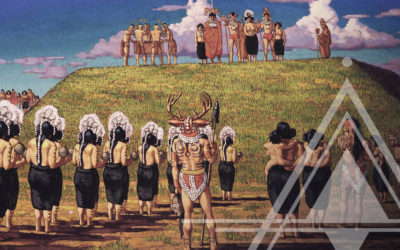Freddy Silva
The Missing Flood Gods
Sept 04
Freddy Silva
Tags
What all these cultures also share in common is the assertion that they inherited a civilization lost to a catastrophe caused by a fragmented meteorite, and an accompanying global flood that closed the Younger Dryas c.9700 BC.
While compiling evidence of this civilization for my latest book The Missing Lands, I wondered whether we’ve dwelled too obsessively over Lemuria and Atlantis to the detriment of other homelands that once were home to ancient architects? It turns out that when we look carefully at ancient traditions, particularly around the Pacific, a more coherent global picture emerges.
The Birthplace of the Gods
The Waitaha are indigenous to Easter Island. They lived there “when the stars shone in a different sky and a different pattern,” when it was composed of “lands and outer islands,” a chain of territories rather than the single island it is today. Every year they welcomed “the appearance of the double-hull canoe of the gods… starwalkers and long distance voyagers” called Urukehu, who sailed from an ancient landmass to the east called Kainga Nuinui (Enormous Land). But one year the canoe failed to return when “angry stars gathered close to the Moon to give birth to the Tides of Chaos, the dreaded Deluge.” A group of Urukehu, bound for New Zealand, survived by sheer luck of being out at sea rather than near shallow water, thus only experiencing massive waves after meteorites struck the ocean.
The Urukehu are described as tall, fair-skinned, red-haired with green eyes, sometimes blonde with blue eyes. And beards. The older moai, with their Caucasian features, extended chins, and hint of goatee, are stylized images of these flood gods, while their ‘hats’, made from red tufa stone, depict their hair color.
After “the world turned by water,” a female descendent of these gods arrived on Easter Island with seven sages to reconnoiter the Pacific and its lands, which understandably had become islands; meanwhile, another child of the Urukehu arrives from a continent to the east. The Waitaha narrative describes how these children of the Urukehu set sail to locate “the birthplace of the gods,” a tri-partite site in a remote mountain region of New Zealand. On its limestone escarpments, their forebears carved the tribal wisdom upon stone monoliths — one representing tutelary goddess of the main site, Marotini, is over fifty feet tall.
The narrative also mentions a calendar stone. Since the ancients memorialized dates and events in the alignment of megaliths and temples, it is possible to match their monuments with background stars to reach a potential date of construction, as famously proved by Bauval and Gilbert with their dating of the Giza pyramids to the rising of Orion on the spring equinox 10,400 BC. The Urukehu were no exception, emphasizing the spring equinox and the winter solstice; Orion and the Southern Cross were also of great significance, and described as such by the Waitaha.
I located a potential candidate for the calendar stone, a massive monolith with an angled disc, featuring a protrusion like a cross between a sun dial and a face, more the work of human hands than natural weathering. Using Stellarium I established that the Southern Cross rose above this marker on the spring equinox 14,800 BC. An alternative correlation is 10,800 BC – the start of the Younger Dryas – when Orion’s Belt is referenced, followed by the entire constellation in 10,400 BC. As this event took place, five miles away, the Marotini stone is facing the Southern Cross. Two iconic monoliths sharing the same time stamp is surely beyond coincidence.
Returning to the Waitaha narrative, when the Urukehu returned across the Pacific, they would bypass Easter Island due to the behaviour of the ocean current, and visit the great land in the east. They took two totem birds with them: titi and caca, commemorated in the name of their ancestral home, Lake Titicaca, home of temple city of Tiwanaku.
Curiously, the triangle established by the three locations places Easter Island at phi, the Golden Ratio.
The Shining Ones of the Andes
Tiwanaku is an Aymara name meaning My People, however, it features the Egyptian syllable aku (shining), essentially making Tiwanaku the city of My Shining People. Together with nearby Puma Punku, and a third, previously unrecognized site, since covered by an oversized church, the three form a perfect equilateral triangle, in the tradition of geodetically aligning related temples. But what makes them antediluvian?
Authur Posnansky’s calculations of a misalignment between the horizon, the Sun and the Kalasasaya— a component of Tiwanaku — places this quadrangle of megaliths in alignment with the sky in 15,000 BC. Even so the Kalasasaya appears have been forced into place between the adjacent Akapana mound and a semi-subterranean temple, both of which are tilted 3-degrees to the south; as is nearby Puma Punku, as though these temples reference the meridian in an even older era. Such a deviation occurs in the Earth’s tilt over a period of 21,600 years, ostensibly placing the three temples closer to 31,000 BC.
But who was responsible? The oldest people of the region, the Puquina, openly discuss fleeing to the Andes when the flood sank their island continent Lupakije, and how the temples around Lake Titicaca were rebuilt by Viracocha with seven craftsmen called Hayhuaypanti, which translates as Shining Ones. Their symbol of office was the serpent, awarded to anyone who’d mastered the Earth’s wandering paths of energy, and such individuals were also called People of the Serpent. They are described as very tall, fair-skinned, red-haired, and featuring elongated skulls, much like those discovered around Paracas, Peru, whose cranial capacity is 25% larger than humans, making this a genetic trait rather than the result of artificial boarding. As to their DNA, it leads to the region of the Black Sea and what used to be Mesopotamia.
Shining Ones of Egypt
The Shining Ones reappear in Egypt, part of a global elite of sages who have been around far longer than academics care to acknowledge. The Turin Papyrus alone lists the Egyptian dynasty spanning 36,000 years, among whom were the Aku Shemsu Hor – Shining Ones, Followers of Horus. The Building Texts list them as between 8.5 to 10 feet tall; they too were longheads. They are described arriving from an island to the south, Ta Neterw, after its partial destruction in a global catastrophe. These gods subsequently established temples in Egypt c.10,400 BC, which coincides with an agricultural revolution along the Nile. One of their leaders, Twt, is claimed as the builder of pyramids before the flood. But the Shining Ones may have built other monuments.
Osirion, An Antediluvian Temple
The Osirion has long been considered an underground temple, except the forty feet of earth surrounding it is in fact compacted silt consistent with a pluvial climate that pervaded the Nile region 10,500-8000 BC. It follows that the temple must have been erected long before, and may well have been a freestanding structure, much like the Valley Temple at Giza, which is built to similar specifications. So, how old is the Osirion?
The clue lies in the name. Osiris is the hero who ascends the Milky Way to the origin of souls, typically the Pole Star or the belt of Orion, to return resurrected as the hawk god Horus. The Osirion does not reference Orion in the past 11,000 years, but during the Younger Dryas a kind of hawk did appear in full upright ascent in the night sky: Cygnus, with its brightest star Deneb aligning with the axis of the Osirion, and riding a vertical Milky Way on the winter solstice and spring equinox 10,500 BC.
Back then Cygnus was regarded not as a swan but as a kite hawk, and therein lies the connection. Egyptian texts refer to Isis as the ‘kite of Osiris’, and she is depicted with the wings of a kite hawk, demonstrating her ability to fan the breath of immortality into those she oversaw.
For this to occur, the soul of the hero must reside in the region of regeneration, the pole star, which was protected by seven circumpolar stars called Indestructibles. And Deneb in Cygnus was one of them. Indestructible also refers to the regenerative nature of the soul, as exemplified by Osiris, whose initiatory rites were performed in the Osirion.
When the water table is sufficiently low inside the temple it is possible to see unusual knobs protruding from its walls, the same enigmatic feature found in the Andean temples. So the Shining Ones were present before and after the flood in both Egypt and the Andes, they shared similar physiognomy and megalithic building methods – as did the Urukehu who, like the Followers of Horus, carried the title Net of the World for their ability to map a rearranged planet and its submerged lands.
Malta’s 14,000 Year Old Temple
The Aku Shemsu Hor might have had a presence on Malta. Tidal waves once dumped 7000 people animals, utensils into the Hypogeum of Hal Saflieni, including hundreds of elongated skull people, suggesting the region was once home to an isolated priestly culture, much as it was in the Andes. Certainly the temples here are of great antiquity. Ggantija is considered the oldest, showing clear signs of heavy damage and the type of water erosion made possible by prolonged exposure to wet weather, which can only be possible if Ggantija was built during the pluvial period of 10,000-8000 BC – a climatic fingerprint it shares with the Giza Plateau, whose valley temples all show the same erosion.
Ggantija features two misaligned axes as though tracking two related yet separate objects simultaneously. Two hills along its horizon were artificially flattened to allow a match to occur with the Major Lunar Standstill, and the spring equinox sunrise, both of which overlap c.12,000 BC.
Yucatan People of the Serpent
Could the Maltese longheads be the same group of tall flood gods who escaped a sinking land in the Atlantic and fled eastwards? In Portugal these survivors were called Offiusa (People of the Serpent), while to the west, in Yucatan, the same gods went by the name Kanuul (People of the Serpent); their given name was Itz (sorcerer, magician). Led by a Caucasian-looking god named Itzamna, these predecessors of the Maya fled a sinking island called Atl, resettled in Yucatan, and built the original Chichen Itza as their headed into Guatemala, settling at Lake Atitlan, which they named after their sunken homeland, where they built their city Utitlan.
Their second center was the island of Nojpeten, on Lake Peten Itza, which once boastid twenty-one temples and a pyramid. This was all dismantled by the Spanish to build the city of Flores, along with its Catholic church which is strangely aligned toward the southeast, thus revealing the pyramid’s original alignment, which faced the rising winter solstice Sun in 7600 BC — that’s 2000 years after the sacred text Chilam Balam dates the arrival of the Itz from Atitlan in 9600 BC, barely 100 years after the end of the Younger Dryas.
This, coincidentally, is the same date given by the Egyptians to the Greek scholar Solon for the sinking of Atl, whose story was immortalized by Plato.
Now it gets strange and complex. Itzamna is a compound of Izanami and Izanagi, the flood gods of Japan c.8000 BC. The suffix nagi or naga, qualifies them as People of the Serpent, a divine bloodline that covered China, Indochina, Polynesia, and India where they were known as Anunage. All these heroes emerged from the flood, accompanied by seven sages, who instructed humans on civilization, built megalithic structures, and behaved like magicians. Always they are described as light-skinned, with blonde or red hair, and very tall. All these attributes converge on a missing hill in Anatolia called Göbekli Tepe.
Gobekli Tepe and the Giza Connection
Its average C-14 dating stands at 9984 BC, except the samples were taken from retaining walls used at the end of the site’s useful life. So when was it actually built?
It’s been suggested that Enclosure D commemorates the setting of Cygnus. This omits two points: Göbekli Tepe’s northern sightline is obscured by 30 feet of summit; and secondly, the ancients rarely celebrated the descent of a celestial object, only its rising or mid-heaven elevation. A re-examination shows Vega, de facto pole star, tracing an elliptical path around the celestial pole on the winter solstice 10,400 BC, falling within the frame of the enclosure’s two central pillars, and directly above Pillar 43, the one carved with vulture glyphs. Vega derives from waqi (falling, swooping), referring to a time when the rotation of its host constellation Lyre resembled a swooping vulture, thus the pillar accurately depicts its motion in the sky. Plus the date fits well with the earliest C-14 date of 10,200 BC.
With its unobstructed southeastern exposure, Göbekli Tepe in 10,400 BC would have seen Orion’s Belt making its highest ascension, its narrow arc framed by pillars 19 and 33. This date reference to Orion raises an important issue. The hill’s original name Portasar means Umbilical Cord of Osiris. Osiris is the embodiment of Orion, and his dwelling at the Giza pyramids commemorates the same date. What could this umbilical cord be? A line drawn from the corner of Menkaure’s pyramid to that of Khufu’s ends beside Gobekli Tepe.
Of Sages, Watchers and the Anu-Nage
Visible from Enclosure D at Göbekli Tepe is the astronomical tower at Harran, where human activity was present by 8000 BC. Harranu, as it was known, means Enclosure of Anu, another group of antediluvian gods. The Mesopotamian flood myth describes an encounter between a scribe by the name Enmed-Ur-Annu and the Lords of Anu, otherwise known as Anunaki (People of Anu), or as they were known in India, Anu-nage (People of the Serpent). They are described as having light skin that required oiling, from which arose the nickname Shining Ones. And yet it was more than that. The Anu oversaw seven groups of seven Apkallu (sages), who went by the nickname Watchers, a group unfairly demonized in Jewish texts for political reasons. The Greeks described them as “those who watch, guard, who are awake,” meaning enlightened protectors, a position equally adopted by the Hopi and Zuni who call them Lookers — gods who were instrumental in helping the Hopi Snake Clan evacuate a Pacific island called Kaskarra after the flood, when the people were called Hisat-Sinom or Anazasi.
Incidentally the Hopi also describe one of their clans evacuating the Atlantic island-continent, which they called Talawaitiichqua.
The Watchers were distinguishable from humans insofar as they possessed knowledge of the mechanics of nature and how to manipulate it, thus they were compared to gods, a view held by the Egyptians, who referred to them as both Urshu (Watchers) and Neterw (force of nature, a god).
The Missing Land of Anu
The homeland of the Watchers and Anunaki home has never been satisfactorily identified. Or has it? I was introduced to the last wisdom keeper of Tongareva, one of the Cook Islands. His peoples’ traditions state that a group of gods arrived from Mesopotamia c.3000 BC, red-haired, fair-skinned sages whom they called Tuanake — Anunaki to you and me. Yet this brotherhood had been present in the Pacific 6000 years earlier, specifically on Easter Island, where a platform commemorates them: Ahu Hananakou. Ahu is a variant of the Egyptian aku, as in Aku Shemsu Hor. The Tongarevan traditions further state that the original homeland of the Lords of Anu was an antediluvian island nation called Te Petaka, described as a secluded, circular island, said to have sunk 11,000 years ago when the region was vastly reshaped by the flood, to became what it is today, the Arabian Peninsula.
There are two surviving pieces of circumstantial evidence supporting this lost land and the sages who once sailed out to teach humanity the civilizing arts. First, there’s a monument in Abu Dhabi that is totally out of character for the region. But a visitor from the Andes would look at it and believe they were still back home — or in ancient Egypt or Easter Island, for that matter, because it features the same style of construction.
The other piece of evidence is Papyrus 1115. It describes the voyage of a sailor down the Red Sea, past Arabia and into the Indian Ocean. The ship is caught in a storm and all hands perish, except the narrator, who is shipwrecked on what he believes to be a deserted island. Soon he meets the leader of the island, who gives him food and a boat and returns him home to Egypt. It is not know when this took place, however, as he embarks, the leader tells the sailor this is the last time he’ll see the island because soon it will vanish under the ocean during a great conflagration.
The sailor describes him as a serpent, with a beard and deep blue eyes.

About the Author
You May Also Like
Join Our Mailing List
Spam sucks. We take your privacy seriously and we will never spam your inbox. You can opt out at any time.




